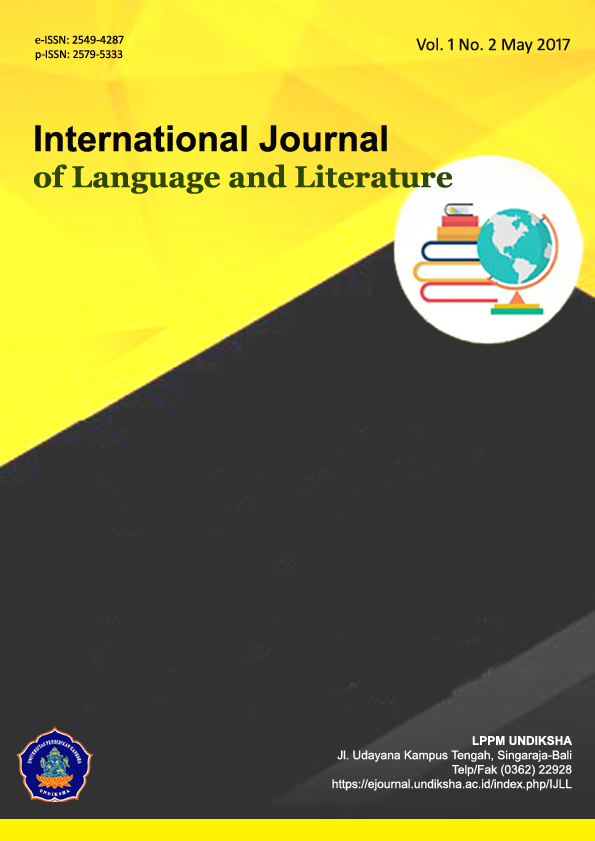A COMPARATIVE STUDY OF THE EFFECT OF DIFFERENT TECHNIQUES OF COOPERATIVE LEARNING AND SELF-CONFIDENCE UPON STUDENTS’ SPEAKING COMPETENCY
DOI:
https://doi.org/10.23887/ijll.v1i2.12539Keywords:
speaking competency, cooperative learning, Jigsaw II, STAD, self-confidence.Abstract
This study focused on: 1) investigating the significant difference in speaking competency between the students taught by using Jigsaw II and those taught by using STAD; 2) investigating the interactional effect between teaching techniques and self-confidence upon students’ speaking competency; 3) investigating the significant difference in speaking competency between the students with high self-confidence taught by Jigsaw II and those taught by STAD; and 4) investigating the significant difference in speaking competency between the students with low self-confidence taught by Jigsaw II and those taught by STAD. The findings show that, firstly, the students treated by Jigsaw II achieve better speaking competency than those treated by STAD; secondly, there is an interactional effect between teaching techniques and self-confidence on the students’ speaking competency; thirdly, the students with high-self-confidence gain higher speaking competency when being treated by Jigsaw II than by STAD; and fourthly, the students with low self-confidence attain the same speaking competency achievement when being treated by Jigsaw II and STAD.
References
Brown, D. 2000. Principles of Language Learning and Teaching. New York: Longman.
Brown, D. 2000. Teaching by Principles: An Interactive Approach to Language Pedagogy (2nd Ed). New York: Longman.
Brown, D. 2003. Language Assessment Principles and Classroom Practices. New York: Longman.
Celce-Murcia, M. 1991. Teaching English as a Second or Foreign Language (2nd Ed). New York: Heinle & Heinle Publishers.
Cohen, E., Brody, C. and Sapon-Shevin, M. 2004. Teaching Cooperative Learning: The Challenge for Teacher Education. New York: State University of New York Press.
Felder, R. and Brent, R. 2001. “Effective Strategies for Cooperative Learning”, J Cooperation & Collaboration in College Teaching, No. 2, Vol. 10, Hal. 69.
Felder, R. and Brent, R. 2007. Cooperative Learning. ACS Symposium Active Learning: Models from the Analytical Sciences. Washington, DC.
Harmer, J. 1998. How to Teach English, An Introduction to The Practice of English Language Teaching. New York: Longman.
Harmer, J. 2007. The Practice of Language Teaching (4th Ed). New York: Longman.
Herrell, A. and Jordan, M. 2004. Fifty Strategies for Teaching English Language Learners (2nd Ed). New Jersey: Pearson.
Hiçyilmaz, A. 2005. “A Review of Cooperative Learning”. Turkish School of Linguistics.
Johnson, R. T. and Johnson, D. W. 2009. “An Educational Psychology Success Story: Socal Interdependence Theory and Cooperative Learning”, American Educational Research Association, No. 5, Vol. 38, Hal. 365.
Johnson, D. W.; Johnson, R. T.; Stanne, M. E. 2000. Cooperative Learning Methods: A meta-analysis. University of Minnesota, Minneapolis: Cooperative Learning Center;http://www.cooperation.org/pages/cl-methods.html (accessed 5th, 2012)
Khan, G., N. 2011. “Effect on Students’ Team Achievement Division (STAD) on Academic Achievement of Students”, Asian Social Science, No. 12, Vol. 7. Hal. 211.
Luoma, S. 2004. Assessing Speaking. Cambridge: Cambridge University Press.
Marhaeni, A., A., I., N. 2010. Asesmen Bahasa yang Bermakna. Orasi Pengenalan Jabatan Guru Besar Tetap dalam Bidang Ilmu Pendidikan Bahasa Inggris pada Fakultas Bahasa dan Seni Universitas Pendidikan Ganesa. Singaraja: Universitas Pendidikan Ganesha.
Maharani, A., A., P. 2012. The Effect of Reciprocal Teaching and Self-Concept upon the Reading Comprehension of the Tenth Grade Students of SMA Negeri 1 Gianyar. (Thesis). Singaraja: Universitas Pendidikan Ganesha.
Molberg, H., K., K. 2010. The Consequence of Motivation and Linguistic Self-Confidence in Relation to Pupils’ Oral Interaction. (Thesis). Tromso: Universitetet i Tromso.
Park, H. and Lee, A. 2006. “L2 Learners’ Anxiety, Self-Confidence and Oral Performance”, Modern Language Journal, No. 1, Vol. 82, Hal. 197.
Prom-D, D. 2012. The Effect of Jigsaw II Technique on Reading Comprehension of Mattayom Suksa 1 Students. (Thesis). Bangkok: Srinakharinwirot University.
Richards, J. 2008. Teaching Listening and Speaking: From Theory to Practice. Cambridge: Cambridge University Press.
Richards, J. and Rodgers, T. 2001. Approaches and Methods in Language Teaching. Cambridge: Cambridge University Press.
Rubio, F. 2007. Self-Esteem and Foreign Language Learning. Newcastle: Cambridge Scholars Publishing.
Sahin, A. 2010. “Effects of Jigsaw II Technique on Academic Achievement and Attitudes to Written Expression Course”, Educational Research and Review, No. 12, Vol 5, Hal. 777.
Slavin, R. 2009. Educational Psychology Theory and Practice. New Jersey: Pearson.
Tong, J. 2004. Little Voice: Students’ Confidence and Their Responses in English Lessons. The Journal of Asia TEFL. No. 1, Vol. 1, Hal. 197.
Wang, T., P. 2007. “The Comparison of the Difficulties between Cooperative Learning and Traditional Teaching Methods in College English Teachers”, The Journal of Human Resource and Adult Learning, No. 2, Vol. 3, Hal. 23.
Wang, T., P. 2009. “Applying Slavin’s Cooperative Learning Techniques to a College EFL Conversation Class”, The Journal of Human Resources and Adult Learning, No. 1, Vol. 5, Hal. 112.
Downloads
Published
How to Cite
Issue
Section
License
IJLL Journal provides immediate open access to its content on the principle that making research freely available to the public to supports a greater global exchange of knowledge.

This work is licensed under a Creative Commons Attribution-ShareAlike 4.0 International License








